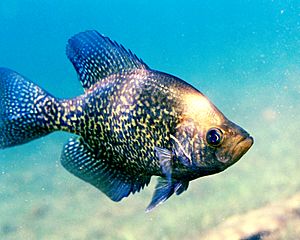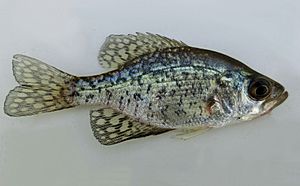Black crappie facts for kids
Quick facts for kids Black crappie |
|
|---|---|
 |
|
| Conservation status | |
| Scientific classification | |
| Synonyms | |
|
The black crappie (Pomoxis nigromaculatus) is a freshwater fish. You can find it in North America. It is one of two types of crappie fish. The black crappie looks a lot like the white crappie. They are similar in size, shape, and how they live. But the black crappie is darker and has a pattern of black spots all over its body.
Contents
What is a Black Crappie?
Black crappies are easy to tell apart from white crappies. They have seven or eight spines on their dorsal fin (the fin on their back). White crappies only have five or six dorsal spines. Crappies have a body that is deep and flat from side to side. They are usually silver-gray to green. They have irregular black spots all over their body.
Black crappies also have rows of dark spots on their dorsal, anal, and tail fins. Their dorsal and anal fins look similar in shape. Both types of crappies have large mouths that reach below their eyes. They also have thin lips. This shows that they are carnivores, meaning they eat other fish.
Crappies are usually about 10 to 20 centimeters (4 to 8 inches) long. The biggest black crappie ever caught weighed about 2.47 kilograms (5.45 pounds). The longest one reported was about 49 centimeters (19.3 inches).
Where Do Black Crappies Live?
The exact native home of the black crappie is not fully known. This is because people have moved them to many new places. But it is thought to be similar to the white crappie's native range. Their original home is likely in the eastern United States and Canada. By 2005, black crappies lived in all 48 states of the contiguous U.S.. You can also find them in Mexico and Panama where they were introduced.
Black crappies live in lakes, reservoirs, and large rivers. They like places with slow or no water current. They also prefer clear water. They need lots of places to hide, like sunken trees or water plants. They also like sandy or muddy bottoms. These are common in lakes, ponds, streams, and sloughs.
Black crappies can have many babies. This means they can sometimes have too many fish in one area. This can be bad for the crappies themselves and for other fish. However, some fish suppliers say you can safely put them in ponds as small as 1 acre (0.4 hectares).
What Do Black Crappies Eat?
Crappies usually eat early in the morning. They also feed from midnight until about 2 AM. Smaller black crappies, less than about 16 centimeters (6.3 inches) long, eat tiny water creatures. These include plankton and small crustaceans. Larger crappies eat small fish, like shad, and minnows.
Adult black crappies eat fewer fish than white crappies do. Instead, they eat more insects and crustaceans. Studies in California showed that mysid shrimp and amphipods were common foods for all sizes of black crappie. What they eat can change a lot. It depends on where they live, what food is available, and how many other fish are competing for food. Young crappies start by eating small water invertebrates. As they grow, they start to eat more fish.
Black Crappies and People
Crappies are a very popular fish for sport fishing. They are easy to catch when they are feeding. There are usually not many rules about how many or how big crappies you can catch.
How to Catch Black Crappies
People often catch crappies using small jigs and minnow rigs. Black crappies are usually caught in clear water around structures. These structures can be sunken trees or plants.
One common way to fish for them is called "spider rigging." This is when a fisherman uses many long rods sticking out from the boat. Each rod has a minnow on it. Fishermen can also troll for crappie with small crankbaits. When trolling, they use electronic devices to find groups of fish. Then they bring their lure close to them.
Another way to fish near docks is called "dock shooting" or "arrow casting." To do this, you use a spinning reel. You open the bail, hold the lure, and bend the rod forward. Then you aim the lure where you want it to go. At the same time, you let go of the lure and release the fishing line. This helps cast the lure into small spaces under a dock or tree.
Conservation Status
Black crappies are not considered to be in danger. They can be caught safely with simple rules. This helps make sure there is no lasting harm to the fish population or their environment. The black crappie is not on the IUCN Red List as a threatened species.
Reproduction and Life Cycle
Black crappies become adults when they are 2 to 4 years old. They grow faster in warmer waters in the southern parts of their range. They grow slower in cooler northern waters. White crappies tend to grow longer than black crappies. Most black crappies caught by fishermen are between 2 and 5 years old.
The time when they breed changes depending on where they live. This is because they live in so many different places. They breed when the water temperature is between 14 and 20 degrees Celsius (58 and 68 degrees Fahrenheit). Spawning happens in the spring and early summer.
The male crappie builds a nest for the eggs. He uses his body and tail to clear an area of sand or mud. This is usually in shallow water, about 30 to 180 centimeters (1 to 6 feet) deep. Nests are often near the shoreline and plants. Black crappies seem to build their nests in the safest places. These spots might have woody debris or live plants.
Female crappies lay an average of 40,000 round eggs. The number of eggs depends on her age and size. After the female lays the eggs, the male guards the nest. He stays until the eggs hatch, which usually takes about 2 to 3 days.
When the baby fish hatch, they are very tiny, about 2.32 millimeters (0.09 inches) long. They look see-through. They stay in the nest for a few days. Then they move to shallow, protected waters.
The oldest black crappie ever recorded lived for fifteen years. But most black crappies live for about seven years.



